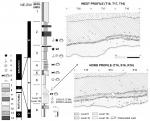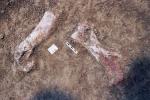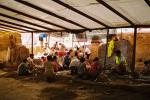Summary (English)
Research (2005-2007)
This site was excavated between 2005 and 2007 and contains a long stratigraphic sequence extending from the late Lower to the early Middle Pleistocene. Evidence of human occupation comes in the shape of lithic tools and fauna with cut marks, which have been identified in levels with reversed polarity from the Early Pleistocene (units EVT7/4) and levels with normal polarity from the start of the Middle Pleistocene (units EVT3/2). The most important archaeological levels are 10 and 10c (EVT7), whose more than 780 m2 have already been the subject of anarea excavation in.
The work resulted in the documentation of an abundant Mode 1 lithic assemblage associated with numerous anthropized faunal remains, which were dated by palaeomagnetism and biostratigraphy of macro and micro-mammalian fauna to the upper limit of the Jaramillo (c. 0.98 Ma) and by ESR/U-series to 0.83 + 0.13 Ma. The unit EVT7 tools are of small format and made with local raw materials. The chaînes opératoires show weakly-developed carving sequences based on bipolar-on-anvil methods and the shaping of lithic flakes, denticulate tools, scrapers and becs on pebbles, clasts, fragments and stone chips, and also a chopper. A technological comparison with Lower Pleistocene sites in Europe would suggest that they all share the same technology (Mode 1) with slight variations. Similarly, the taphonomic and archaeozoological analyses from Vallparadis, Orce and Atapuerca indicate that they have common adaptive strategies. All these technological and adaptive characteristics made it possible for the human populations of the Iberian Peninsula to compete for resources with large carnivores and adapt to different ecosystems and changes in climate.
Archaeological work on the upper sequence (units EVT4/2) brought to light a lithic assemblage made using longer chaînes opératoires. It also showed an increase in the size of the artefacts and a better choice of raw materials for carving. This would indicate changes in collection areas frequented by the hominids related to the appearance of Mode 2.
In order to complete the chronostratigraphic framework, datings were carried out on samples of quartz grains extracted from sediment and tooth fossils using ESR (Electron Spin Resonance) and ESR combined with uranium-thorium. The results are very significant and tally with those obtained using biochronology and palaeomagnetism. The Vallparadis site now has an accurate, consistent chronostratigraphic framework that enables it to be placed chronologically at the end of the Lower Pleistocene, within a time scale running between the Jaramillo and Brunhes geomagnetic events. Along with the TD-6 Gran Dolina and the TE-9 Sima del Elefante in the Atapuerca Mountains (Burgos), this is a key site for studying the earliest human settlements in Europe.
- Joan Garcia Garriga y Kenneth Martínez Molina
Director
- Eudald Carbonell Roura, Institut Català de Paleoecologia Humana i Evolució Social (IPHES); Joan Garcia Garriga, Institut Català de Paleoecologia Humana i Evolució Social (IPHES)/Universitat Oberta de Catalunya (UOC); Kenneth Martínez Molina, Institut Català de Paleoecologia Humana i Evolució Social (IPHES).
Team
- Maria Alabau Janer; Nadine Alber; Mireia Aragonés Fusté; Josep Oriol Arisa Manchón; Raquel Aarroyo Trenado; Josefa Atienza Sánchez; Carmen Ayet Reverter; Mercè Baeta Ferrer; Amèlia Bargalló Ferrerons; Alfonso Barragán Villena; Mireia Bassols Casi; Marina Bello López; Antonio Blázquez Martín Mulas; María Ester Brieva Adánez; Eloisa Ana Cabral Fernández; Joan Calvet Bernat; Raúl Campuzano Illanes; Fernando Cañas García; Nagore Cobo Lechuga; Maria Mercè Chaler Giner; Azucena Chueca Martínez; Patricia de Inés Sutil; Jesús de la Torre Sánchez; José Manuel del Rosal Moreno; Isabel Díaz Muñoz; Cristian Domínguez Bolaños; Raquel Ferrer Fustes; Antoni Ramon Ferrer Santín; Manuel Felipe Frias Ferreira; Maite Garcia Rojas; Irene García Rovira; Francisco Javier García Vadillo; María Garicano Lanuza; Alejandro Gil Gallardo; Miquel Àngel Gil Parra; María Teresa Giráldez Cortés; Rafael Gil Giraldo Aguilar; Alexandre Gómez González‐Dopeso; Maria Alejandra Guerra Terra; Manuel David Guerrero Lozano; Roger Guerris Farré; Joan Guivernau Perea; María Carmen Gutiérrez Casas; Mónica Haro Villanueva; Miguel Ángel Hidalgo Rodríguez; Rosana Ibáñez Lacasa; Gemma Ibars Pérez; José Ignacio Jiménez Gordon; Marc Jobani Fernández; Talía Lazuén Fernández; José Manuel Lojo Galán; Jesús López Corral; Jéssica Llop Ramos; Anna Martí Ferragut; María Luisa Martín Juárez; Felipe Esteban Masó Ferrer; Álvaro Mata Sánchez; Carlos Merchán Santos, Mónica Millán Juárez; Davinia Moreno García; Greta Mustieles Salvador; Alfonso Oblanca Gonzalo; María Carmen Olivares Marín; Silvia María Olivares Martínez; Anabel Ortiz López; Yolanda Pascual Moncada; César Marco Pérez García; David Jesús Pérez Olivé; Vanesa Perona Quevedo; Andreia Pinto Anacleto; Susana Poblador Fernández; Litharenia Polychronopoulou; Francisco Portalo Núñez; Francisco José Presa Olmo; Dolores Redondo Hierro; Jorge Luís Rodríguez Rivas; Sergio Romero Girón; Renata Rosa; Miquel Rovira Formento; Luís Rubio Masero; Karim Ruiz Rosell; Raquel Sánchez Espinosa; Policarpo Sánchez Yustos; Jesús Santos Casaus; Jorge Sanz Sande; Alexandre Solé Raventós; María Soria Saiz; Ida María Szatkowska; Marcos Terradillos Bernal; Jaume Vilalta Ollé; Paula Vanesa Viviani San Emeterio; Beatriz Vizuete Rangel; Victoria Vizuete Rangel; Andrew Jon Williams; Alicia Xicota Viñe.
- Jordi Fernández Rubio
- Joan Garcia Garriga, Institut Català de Paleoecologia Humana i Evolució Social (IPHES)/Universitat Oberta de Catalunya (UOC); Kenneth Martínez Molina, Institut Català de Paleoecologia Humana i Evolució Social (IPHES).
- Manuel Gómez
Research Body
- Fundació Universitat Rovira i Virgili (FURV); Àrea de Coneixement i Recerca de la Generalitat de Catalunya; Institut Català de Paleoecologia Humana i Evolució Social (IPHES).
Funding Body
- Departament de Política Territorial i Obres Públiques-GISA (Genaralitat de Catalunya).






![Download [PDF]](/excavation/skins/fasti/images/results/download_sml.png)



